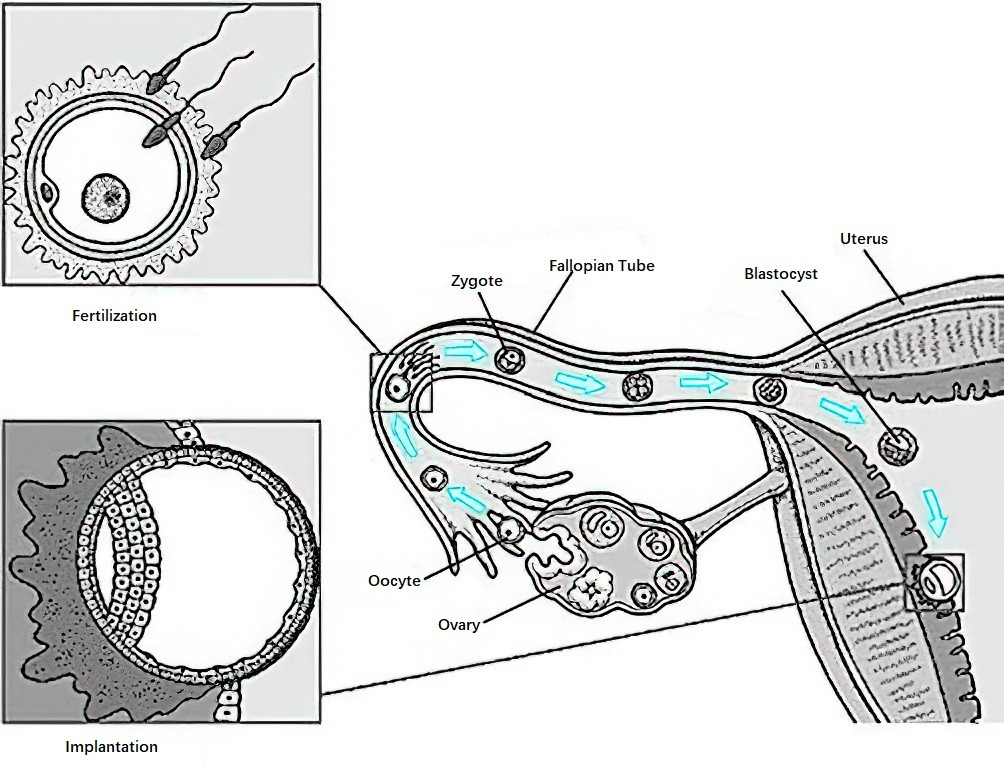The process in which capacitated sperm combines with a secondary oocyte in the fallopian tube to form a zygote is referred to as fertilization. Fertilization typically occurs within a few hours after ovulation and generally does not exceed 24 hours. The process in which the blastocyst implants into the endometrium is known as implantation (or nidation).
Formation of the Zygote
After semen is ejaculated into the vagina, sperm leave the seminal fluid and travel through the cervical canal, uterine cavity, and into the fallopian tube. During this period, glycoproteins on the surface of the sperm's acrosome are degraded by α and β amylases in the reproductive tract secretions. Concurrently, changes occur in the cholesterol-to-phospholipid ratio and membrane potential of the acrosomal membrane, reducing the stability of the acrosomal membrane. This process is known as sperm capacitation and requires approximately 7 hours.
Upon release from the ovary, the oocyte (secondary oocyte) enters the fallopian tube through the infundibulum. In the tube, the capacitated sperm encounters the oocyte. The sperm's acrosome outer membrane ruptures, releasing acrosomal enzymes such as acrosin, hyaluronidase, and esterases to break down the radiating corona and zona pellucida surrounding the oocyte. This is referred to as the acrosome reaction. Through the action of these enzymes, the sperm penetrates the corona radiata and zona pellucida. Only sperm that undergo the acrosome reaction can fuse with the secondary oocyte.
When the sperm head comes into contact with the surface of the oocyte, cortical granules within the oocyte cytoplasm release lysosomal enzymes. This causes structural changes in the zona pellucida and denaturation of sperm receptor molecules, which prevents additional sperm from penetrating the zona pellucida. This event is termed the zona reaction. The sperm that successfully penetrates the zona pellucida interacts with and fuses with the oocyte plasma membrane, allowing the sperm to enter the oocyte.
The oocyte then completes its second meiotic division, forming a female pronucleus. The male pronucleus from the sperm and the female pronucleus from the oocyte fuse, resulting in the dissolution of nuclear membranes and the mixing of chromosomes to form a diploid zygote, completing the process of fertilization.
Approximately 30 hours after fertilization, the zygote begins migration toward the uterine cavity through fallopian tube contractions and ciliary movement of the fallopian epithelium. At the same time, the zygote undergoes mitotic division, termed cleavage, producing multiple daughter cells referred to as blastomeres. By 50 hours post-fertilization, the zygote reaches the 8-cell stage, and by 72 hours, it forms a 16-cell solid mass known as a morula. On the fourth day after fertilization, the morula reaches the uterine cavity. Over subsequent days, cell divisions continue and uterine fluid accumulates in the intercellular spaces, leading to the formation of an early blastocyst. By the 5th or 6th day post-fertilization, the zona pellucida gradually dissipates, and the blastocyst fully hatches and rapidly increases in size.
Implantation of the Zygote
Approximately 6 to 7 days post-fertilization, the embryo begins the process of implantation into the uterine endometrium. Implantation involves three stages: apposition, adhesion, and invasion.
- Apposition: After the disappearance of the zona pellucida, the blastocyst makes contact with the endometrium via its inner cell mass.
- Adhesion: The blastocyst adheres to the endometrium, and trophoblast cells on its surface differentiate into two layers: syncytiotrophoblast (outer layer) and cytotrophoblast (inner layer).
- Invasion: The trophoblast cells penetrate and invade the endometrium, the inner third of the myometrium, and blood vessels, embedding the blastocyst entirely within the endometrium and covering it.
Successful implantation of the zygote requires certain conditions:
- Disappearance of the zona pellucida.
- Differentiation of syncytiotrophoblasts from cytotrophoblast cells of the blastocyst.
- Synchronized development and functional coordination between the blastocyst and endometrium.
- Sufficient secretion of estrogen and progesterone within the body.
For successful implantation, the endometrium must attain receptivity. This process is supported by estrogen and progesterone secreted by the corpus luteum. Endometrial receptivity exists only during days 20 to 24 of the menstrual cycle, referred to as the implantation window. During this very brief period, the endometrium permits implantation of the zygote.

Figure 1 Fertilization, development, transport, and implantation of the zygote
Following implantation, the endometrial stromal cells undergo proliferation and differentiation to form large, rounded, multinucleated decidual cells with abundant cytoplasm. This process is termed endometrial decidualization. Depending on location, the decidua is categorized into the decidua basalis, decidua capsularis, and decidua parietalis.